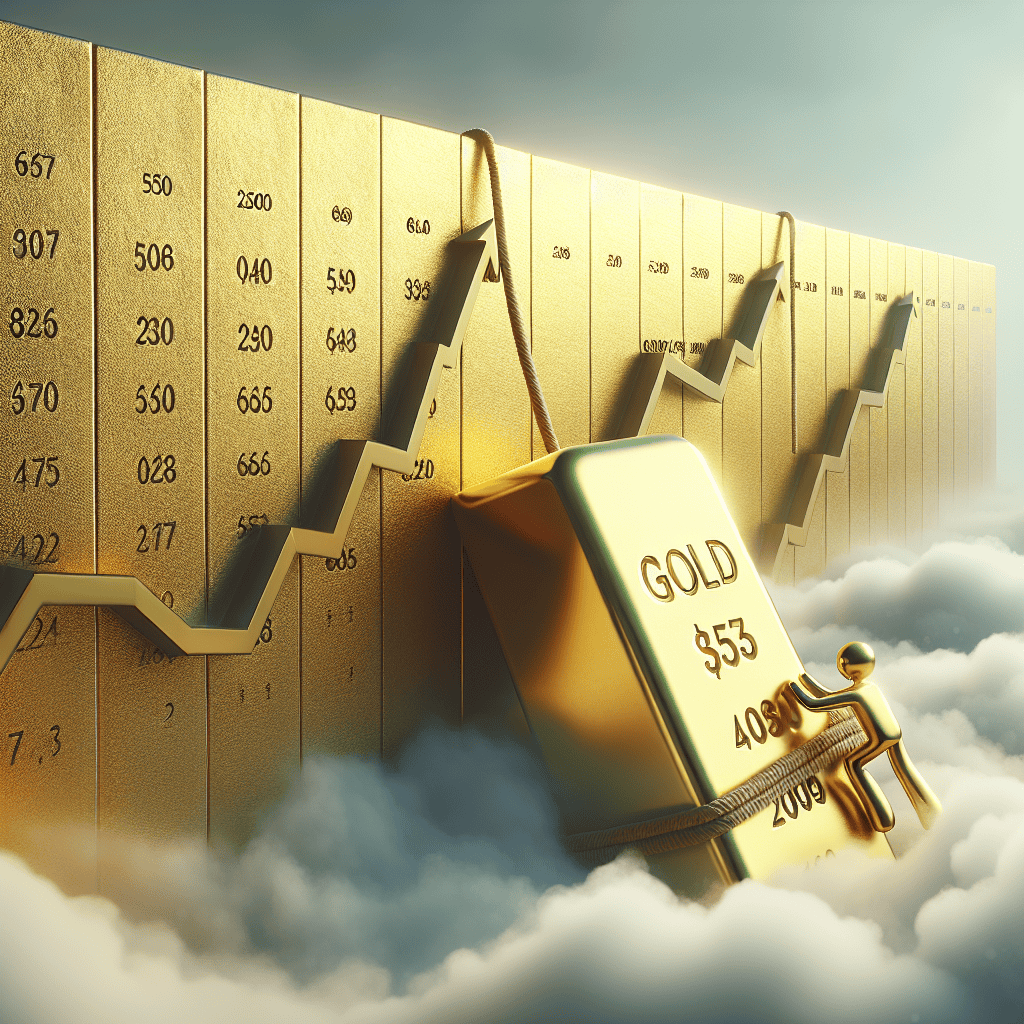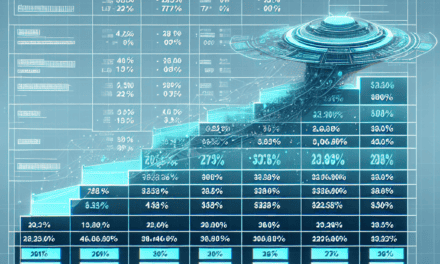“Gold: The Unreachable Summit of Value”
Introduction
Gold’s price ceiling remains elusive due to a complex interplay of global economic factors, investor behavior, and market dynamics. As a traditional safe-haven asset, gold’s value is influenced by geopolitical tensions, inflation rates, and currency fluctuations, which can drive demand and impact prices unpredictably. Additionally, central bank policies and interest rates play a crucial role in shaping investor sentiment towards gold. The metal’s intrinsic value, coupled with its limited supply and diverse industrial applications, further complicates the establishment of a definitive price ceiling. Consequently, gold’s market remains volatile, with its price subject to rapid changes in response to shifting economic landscapes and investor strategies.
Historical Volatility Of Gold Prices
Gold has long been regarded as a symbol of wealth and a safe haven for investors during times of economic uncertainty. Its allure is not only rooted in its physical properties but also in its historical role as a stable store of value. However, despite its reputation, the price of gold has exhibited significant volatility over the years, making the concept of a price ceiling elusive. Understanding the historical volatility of gold prices requires an examination of the various factors that have influenced its market value over time.
To begin with, gold’s price is heavily influenced by macroeconomic factors, including inflation rates, currency fluctuations, and geopolitical tensions. During periods of high inflation, investors often flock to gold as a hedge against the eroding value of paper currencies. This increased demand can drive up prices, as seen during the 1970s when inflationary pressures led to a dramatic rise in gold prices. Conversely, when inflation is low and currencies are stable, the demand for gold may wane, leading to price declines. Thus, the interplay between inflation and currency stability plays a crucial role in gold’s price volatility.
Moreover, gold prices are also affected by changes in interest rates. When interest rates are low, the opportunity cost of holding non-yielding assets like gold decreases, making it more attractive to investors. This was evident during the global financial crisis of 2008 when central banks around the world slashed interest rates to stimulate economic growth, resulting in a surge in gold prices. On the other hand, rising interest rates can lead to a stronger currency and higher yields on other investments, reducing the appeal of gold and putting downward pressure on its price.
In addition to economic factors, geopolitical events have historically contributed to the volatility of gold prices. Political instability, wars, and other crises often lead to increased demand for gold as a safe haven asset. For instance, during the Gulf War in the early 1990s and the subsequent conflicts in the Middle East, gold prices experienced significant fluctuations as investors sought refuge from the uncertainties of global politics. These events underscore the sensitivity of gold prices to geopolitical developments, further complicating the establishment of a price ceiling.
Furthermore, the supply and demand dynamics within the gold market itself can lead to price volatility. Gold mining production, central bank reserves, and consumer demand for jewelry and technology all influence the supply side of the equation. Any disruptions in mining operations or changes in central bank policies can have immediate effects on gold prices. Similarly, shifts in consumer preferences or technological advancements can alter demand patterns, contributing to price fluctuations.
Despite these factors, predicting a definitive price ceiling for gold remains challenging. The interplay of economic indicators, geopolitical events, and market dynamics creates a complex environment where gold prices can rise or fall unpredictably. While historical trends provide some insight into potential price movements, the inherent volatility of gold makes it difficult to establish a fixed upper limit.
In conclusion, the historical volatility of gold prices is a reflection of the myriad factors that influence its market value. From macroeconomic conditions and interest rates to geopolitical events and supply-demand dynamics, each element plays a role in shaping the price of gold. As a result, the notion of a price ceiling remains elusive, with gold continuing to serve as both a barometer of economic sentiment and a refuge in times of uncertainty. Understanding these complexities is essential for investors seeking to navigate the ever-changing landscape of the gold market.
Influence Of Global Economic Uncertainty
Gold has long been regarded as a safe haven asset, a reliable store of value in times of economic uncertainty. Its allure is particularly pronounced during periods of global economic instability, when investors seek refuge from volatile markets and depreciating currencies. Despite its historical role as a financial bulwark, the price ceiling of gold remains elusive, influenced by a myriad of factors that contribute to its complex valuation dynamics.
To begin with, global economic uncertainty often triggers a flight to safety, with investors flocking to gold as a hedge against potential downturns. This demand surge typically drives up prices, yet the extent to which gold can appreciate is tempered by several countervailing forces. For instance, the strength of the U.S. dollar plays a pivotal role in gold’s valuation. As gold is priced in dollars, a robust dollar can dampen gold’s appeal to foreign investors, thereby capping its price growth. Conversely, a weaker dollar tends to bolster gold prices, but this relationship is not always linear, as other economic variables come into play.
Moreover, interest rates significantly impact gold’s price trajectory. In an environment of rising interest rates, the opportunity cost of holding non-yielding assets like gold increases, often leading to a decline in demand. Central banks’ monetary policies, therefore, exert considerable influence over gold prices. When central banks adopt an accommodative stance, lowering interest rates to stimulate economic growth, gold tends to benefit as investors seek alternatives to low-yielding bonds. However, when rates rise, the allure of gold can diminish, placing a ceiling on its price.
In addition to these macroeconomic factors, geopolitical tensions and crises also contribute to gold’s price movements. Events such as trade wars, military conflicts, and political instability can spur demand for gold as a protective asset. While these events can lead to short-term price spikes, their long-term impact on gold’s price ceiling is less predictable. The resolution of such crises often results in a reversion to previous price levels, underscoring the transient nature of geopolitical influences.
Furthermore, the supply side of the gold market cannot be overlooked. Gold mining production and the recycling of existing gold stocks play crucial roles in determining the metal’s availability. Any disruptions in mining operations, whether due to regulatory changes, labor strikes, or environmental concerns, can constrain supply and exert upward pressure on prices. However, technological advancements and improved mining techniques have generally ensured a steady supply, preventing dramatic price escalations.
Additionally, the advent of digital currencies and alternative investment vehicles has introduced new dynamics into the gold market. Cryptocurrencies, in particular, have emerged as potential competitors to gold, offering investors a different form of asset diversification. While the long-term implications of digital currencies on gold’s price ceiling remain uncertain, their growing popularity suggests a shift in investor preferences that could influence gold’s traditional role as a safe haven.
In conclusion, while global economic uncertainty undeniably influences gold prices, the metal’s price ceiling remains elusive due to a confluence of factors. The interplay between currency strength, interest rates, geopolitical events, supply dynamics, and emerging investment alternatives creates a complex landscape that defies simple predictions. As such, while gold will likely continue to serve as a refuge in turbulent times, its ultimate price potential is shaped by an intricate web of interrelated elements that resist easy quantification.
Impact Of Central Bank Policies On Gold
The price of gold has long been a subject of fascination and speculation, with investors and economists alike attempting to predict its movements. One of the most significant factors influencing the price of gold is the monetary policy decisions made by central banks around the world. These policies, which include interest rate adjustments, quantitative easing, and currency interventions, have a profound impact on the demand for and value of gold. Understanding the relationship between central bank policies and gold prices is crucial for anyone looking to grasp why gold’s price ceiling remains elusive.
To begin with, central banks play a pivotal role in shaping economic conditions through their control over interest rates. When central banks lower interest rates, borrowing becomes cheaper, encouraging spending and investment. This often leads to inflationary pressures, which can erode the purchasing power of fiat currencies. In such scenarios, gold is often seen as a safe haven asset, as it tends to retain its value over time. Consequently, lower interest rates can lead to increased demand for gold, driving up its price. Conversely, when central banks raise interest rates to combat inflation, the opportunity cost of holding non-yielding assets like gold increases, potentially leading to a decrease in its price.
Moreover, the implementation of quantitative easing (QE) by central banks has also had a significant impact on gold prices. QE involves the large-scale purchase of government securities or other financial assets to inject liquidity into the economy. This increase in money supply can lead to concerns about future inflation, prompting investors to seek refuge in gold. The correlation between QE and rising gold prices has been observed in various instances, such as during the financial crisis of 2008 and the economic disruptions caused by the COVID-19 pandemic. However, the eventual tapering of QE programs can lead to a reversal of this trend, as seen when central banks signal a return to more conventional monetary policies.
In addition to interest rates and QE, currency interventions by central banks can also influence gold prices. When a central bank intervenes in the foreign exchange market to devalue its currency, the relative value of gold, which is typically priced in U.S. dollars, can increase. This is because a weaker currency makes gold cheaper for foreign investors, boosting demand. On the other hand, if a central bank takes measures to strengthen its currency, the price of gold may face downward pressure.
Despite these influences, predicting the exact ceiling for gold prices remains challenging due to the complex interplay of global economic factors. Geopolitical tensions, changes in supply and demand dynamics, and shifts in investor sentiment all contribute to the volatility of gold prices. Furthermore, the actions of central banks are often reactive to unforeseen economic developments, adding another layer of unpredictability.
In conclusion, while central bank policies undeniably impact gold prices, they are just one piece of a larger puzzle. The elusive nature of gold’s price ceiling can be attributed to the myriad of factors that interact in the global economy. As central banks continue to navigate the delicate balance between stimulating growth and controlling inflation, the price of gold will likely remain subject to fluctuations, reflecting the ever-changing economic landscape. Understanding these dynamics is essential for investors seeking to make informed decisions in the precious metals market.
Role Of Geopolitical Tensions In Gold Valuation

Gold has long been regarded as a safe haven asset, a reliable store of value during times of economic uncertainty and geopolitical tension. Its allure is rooted in its historical role as a universal currency and a hedge against inflation. However, despite its enduring appeal, the price ceiling of gold remains elusive, largely due to the complex interplay of geopolitical factors that influence its valuation. Understanding the role of these tensions in gold valuation requires a nuanced examination of the global landscape.
Geopolitical tensions often lead to increased volatility in financial markets, prompting investors to seek refuge in assets perceived as stable and secure. Gold, with its intrinsic value and limited supply, naturally becomes an attractive option. For instance, during periods of heightened conflict or political instability, such as the ongoing tensions in the Middle East or the strained relations between major powers like the United States and China, investors tend to flock to gold. This increased demand can drive up prices, yet the extent to which these prices rise is often moderated by other factors.
One significant factor is the strength of the U.S. dollar. Gold is typically priced in dollars, meaning that fluctuations in the currency’s value can have a direct impact on gold prices. When geopolitical tensions arise, the dollar often strengthens as investors seek the relative safety of U.S. assets. This can counterbalance the upward pressure on gold prices, as a stronger dollar makes gold more expensive for holders of other currencies, potentially dampening demand.
Moreover, central bank policies play a crucial role in shaping gold’s valuation. In response to geopolitical tensions, central banks may adjust interest rates or engage in quantitative easing to stabilize their economies. Such measures can influence investor behavior and, consequently, gold prices. For example, lower interest rates reduce the opportunity cost of holding non-yielding assets like gold, potentially boosting its appeal. Conversely, higher rates might deter investment in gold, as investors seek higher returns elsewhere.
Additionally, the global supply and demand dynamics of gold are influenced by geopolitical developments. Mining operations in politically unstable regions may face disruptions, affecting supply and contributing to price volatility. On the demand side, countries experiencing geopolitical tensions may increase their gold reserves as a strategic move to safeguard their economies, further impacting prices.
While geopolitical tensions undeniably affect gold valuation, predicting their precise impact is challenging due to the multifaceted nature of these events. Each geopolitical situation is unique, with its own set of variables and potential outcomes. Consequently, the market’s response to such tensions can be unpredictable, leading to fluctuations in gold prices that defy straightforward analysis.
In conclusion, the elusive price ceiling of gold can be attributed to the intricate web of geopolitical factors that influence its valuation. While gold remains a favored asset during times of uncertainty, its price is subject to a myriad of influences, including currency fluctuations, central bank policies, and supply-demand dynamics. As geopolitical tensions continue to shape the global landscape, understanding their role in gold valuation becomes increasingly important for investors seeking to navigate the complexities of the market. Through careful analysis and consideration of these factors, investors can better anticipate the potential movements in gold prices, even as the quest for a definitive price ceiling remains an ongoing challenge.
Gold’s Relationship With Inflation And Deflation
Gold has long been regarded as a hedge against economic uncertainty, with its price often reflecting broader macroeconomic trends. One of the most significant factors influencing gold’s price is its relationship with inflation and deflation. Understanding this dynamic is crucial to comprehending why gold’s price ceiling remains elusive. Historically, gold has been perceived as a store of value, particularly during periods of inflation. When inflation rises, the purchasing power of fiat currencies tends to decline, prompting investors to seek refuge in assets that can preserve their wealth. Gold, with its intrinsic value and limited supply, often becomes an attractive option. As demand for gold increases, its price typically rises, creating a correlation between inflationary pressures and gold’s market value.
However, the relationship between gold and inflation is not always straightforward. While inflation can drive up gold prices, other factors, such as interest rates and currency fluctuations, can also play a significant role. For instance, when central banks raise interest rates to combat inflation, the opportunity cost of holding non-yielding assets like gold increases. This can lead to a decrease in demand for gold, potentially offsetting the inflationary impact on its price. Consequently, the interplay between inflation and interest rates can create a complex environment for gold pricing.
In contrast, during periods of deflation, the dynamics shift. Deflation is characterized by a general decline in prices, often accompanied by reduced consumer spending and economic stagnation. In such scenarios, the demand for gold can be influenced by a flight to safety. Investors may turn to gold as a protective measure against economic instability, driving up its price. However, deflation can also lead to a stronger currency, as the purchasing power of money increases. A stronger currency can make gold more expensive for foreign investors, potentially dampening demand and exerting downward pressure on its price.
Moreover, the global nature of gold markets adds another layer of complexity. Gold is traded internationally, and its price is influenced by a myriad of factors beyond domestic inflation and deflation. Geopolitical tensions, changes in mining output, and shifts in investor sentiment can all impact gold prices. For example, during times of geopolitical uncertainty, such as conflicts or trade disputes, investors often flock to gold as a safe haven, driving up its price regardless of inflationary or deflationary trends.
Additionally, technological advancements and changes in consumer preferences can also affect gold’s market dynamics. The rise of digital currencies and alternative investments has introduced new variables into the equation, potentially altering traditional perceptions of gold as a safe haven. As these factors continue to evolve, they contribute to the ongoing challenge of predicting gold’s price ceiling.
In conclusion, while gold’s relationship with inflation and deflation is a key determinant of its price, it is not the sole factor. The interplay between inflation, deflation, interest rates, currency fluctuations, and global events creates a complex and dynamic environment for gold pricing. As a result, predicting a definitive price ceiling for gold remains elusive. Investors and analysts must consider a wide range of variables and remain vigilant in monitoring the ever-changing economic landscape to gain a comprehensive understanding of gold’s market behavior.
Speculative Trading And Its Effect On Gold Prices
Gold has long been considered a safe haven for investors, particularly during times of economic uncertainty. Its allure lies in its perceived stability and intrinsic value, which often leads to increased demand when other assets appear volatile. However, despite its historical significance and enduring appeal, gold’s price ceiling remains elusive, largely due to the complex dynamics of speculative trading. Understanding the impact of speculative trading on gold prices requires a closer examination of market behaviors and investor psychology.
Speculative trading, by its very nature, involves buying and selling assets with the expectation of profiting from short-term price movements. In the context of gold, speculators often enter the market with the aim of capitalizing on anticipated fluctuations, driven by factors such as geopolitical tensions, currency devaluations, or changes in interest rates. These traders, unlike traditional investors who may hold gold for its long-term value, are primarily focused on short-term gains. Consequently, their activities can lead to increased volatility in gold prices, as they react swiftly to market news and trends.
One of the primary ways speculative trading affects gold prices is through the use of derivatives, such as futures and options. These financial instruments allow traders to bet on the future price of gold without actually owning the physical commodity. While derivatives can provide liquidity and facilitate price discovery, they also introduce a layer of complexity that can amplify price swings. For instance, when a large number of speculators take positions based on anticipated price movements, it can create a self-fulfilling prophecy, driving prices up or down in the short term.
Moreover, speculative trading is often influenced by macroeconomic indicators and central bank policies. For example, when central banks signal changes in interest rates, it can lead to shifts in investor sentiment. A potential increase in interest rates might prompt speculators to sell gold, anticipating a stronger dollar and higher yields on other investments. Conversely, expectations of lower interest rates can lead to increased buying, as gold becomes more attractive relative to interest-bearing assets. These rapid shifts in sentiment can result in significant price fluctuations, further complicating the establishment of a stable price ceiling for gold.
In addition to macroeconomic factors, speculative trading is also driven by technological advancements and the proliferation of algorithmic trading. High-frequency trading algorithms can execute trades in milliseconds, responding to market signals faster than any human trader. While this can enhance market efficiency, it also means that gold prices can be subject to rapid and unpredictable changes, as algorithms react to even the slightest market movements. This technological aspect of speculative trading adds another layer of complexity to the already intricate dynamics of gold pricing.
Despite the challenges posed by speculative trading, it is important to recognize that it is not inherently detrimental to the gold market. Speculators provide liquidity, enabling other market participants to buy and sell with greater ease. However, the influence of speculative trading on gold prices underscores the difficulty in establishing a definitive price ceiling. As long as gold remains a focal point for speculative activity, its price will continue to be shaped by a myriad of factors, making it challenging to predict with certainty. In conclusion, while gold’s intrinsic value and historical significance remain intact, the elusive nature of its price ceiling is a testament to the complex interplay of speculative trading and market forces.
Technological Advancements In Gold Mining And Supply
The quest to understand why gold’s price ceiling remains elusive is a multifaceted endeavor, intricately tied to various factors, including technological advancements in gold mining and supply. Over the years, technological innovations have significantly transformed the gold mining industry, enhancing efficiency and increasing the global supply of this precious metal. These advancements have played a crucial role in preventing gold prices from reaching an insurmountable peak, as they continuously adjust the balance between supply and demand.
To begin with, the introduction of sophisticated machinery and equipment has revolutionized the extraction process. Modern mining techniques, such as open-pit mining and underground mining, have become more efficient due to the use of advanced machinery. These technologies allow for the extraction of gold from deeper and more challenging terrains, which were previously inaccessible or economically unfeasible. Consequently, the ability to tap into new reserves has expanded the global supply of gold, thereby exerting downward pressure on prices.
Moreover, the implementation of automation and digital technologies has further enhanced productivity in gold mining operations. Automation reduces the reliance on manual labor, minimizing human error and increasing operational efficiency. For instance, automated drilling and hauling systems have streamlined the extraction process, leading to a more consistent and reliable output. Additionally, digital technologies, such as data analytics and artificial intelligence, have enabled mining companies to optimize their operations by predicting equipment failures and improving resource management. These improvements contribute to a steady supply of gold, which in turn influences market dynamics and price stability.
In addition to extraction, technological advancements have also impacted the processing and refining stages of gold production. Innovations in metallurgical processes have improved the recovery rates of gold from ore, ensuring that a higher percentage of the metal is extracted from mined material. Techniques such as bioleaching and pressure oxidation have made it possible to process lower-grade ores that were once considered uneconomical. This has further expanded the available supply of gold, as previously untapped resources are now being utilized.
Furthermore, the recycling of gold has become an increasingly important component of the supply chain, driven by technological progress. Advanced recycling methods have made it possible to recover gold from electronic waste and other sources with greater efficiency. As a result, recycled gold now constitutes a significant portion of the overall supply, providing an additional buffer against price spikes.
While technological advancements have undeniably bolstered the supply side of the equation, it is essential to consider their interplay with demand factors. The demand for gold is influenced by various elements, including its role as a safe-haven asset, jewelry consumption, and industrial applications. However, the consistent increase in supply facilitated by technological progress has often outpaced demand growth, preventing prices from reaching a definitive ceiling.
In conclusion, the elusive nature of gold’s price ceiling can be attributed, in part, to the continuous technological advancements in gold mining and supply. These innovations have not only increased the efficiency and scope of extraction but have also enhanced processing and recycling capabilities. As a result, the global supply of gold remains robust, exerting a stabilizing influence on prices. While demand dynamics continue to play a crucial role, the technological strides in the industry ensure that the balance between supply and demand remains in a state of flux, keeping gold’s price ceiling perpetually out of reach.
Q&A
1. **What factors contribute to the elusive price ceiling of gold?**
Gold’s price ceiling remains elusive due to factors such as fluctuating global economic conditions, currency value changes, geopolitical tensions, and varying demand from central banks and investors.
2. **How does inflation impact gold prices?**
Inflation often leads to higher gold prices as investors seek to protect their wealth from eroding purchasing power, making gold a popular hedge against inflation.
3. **What role do central banks play in gold pricing?**
Central banks influence gold prices through their buying and selling activities, as well as their monetary policies, which can affect currency values and investor confidence.
4. **How do geopolitical tensions affect gold prices?**
Geopolitical tensions typically drive up gold prices as investors flock to safe-haven assets during times of uncertainty and potential conflict.
5. **Why does currency fluctuation impact gold prices?**
Gold is priced in U.S. dollars, so fluctuations in the dollar’s value can make gold more or less expensive for foreign investors, impacting demand and price.
6. **What is the relationship between interest rates and gold prices?**
Generally, higher interest rates can lead to lower gold prices as they increase the opportunity cost of holding non-yielding assets like gold, while lower rates can boost gold demand.
7. **How does investor sentiment influence gold’s price ceiling?**
Investor sentiment, driven by market trends and economic outlooks, can lead to increased buying or selling of gold, affecting its price and making a definitive ceiling difficult to establish.
Conclusion
Gold’s price ceiling remains elusive due to a combination of factors that influence its market dynamics. Firstly, gold is often seen as a safe-haven asset, attracting investors during times of economic uncertainty, geopolitical tensions, or inflationary pressures, which can drive up demand and prices. Secondly, the supply of gold is relatively inelastic; mining production cannot be rapidly increased to meet sudden spikes in demand, which can prevent prices from stabilizing at a ceiling. Additionally, central banks around the world hold significant gold reserves and can influence the market through their buying and selling activities. Furthermore, currency fluctuations, particularly in the U.S. dollar, impact gold prices since it is typically priced in dollars; a weaker dollar can lead to higher gold prices and vice versa. Lastly, speculative trading and investment in gold derivatives can lead to price volatility, making it difficult to establish a stable price ceiling. These factors, combined with the complex interplay of global economic conditions, ensure that gold’s price remains dynamic and resistant to a fixed ceiling.





